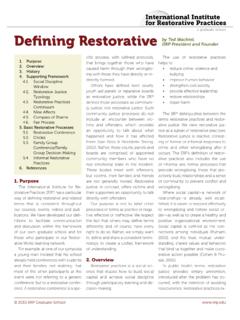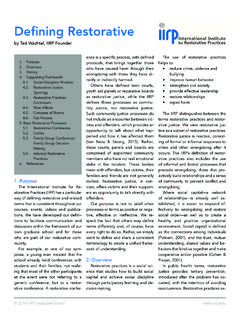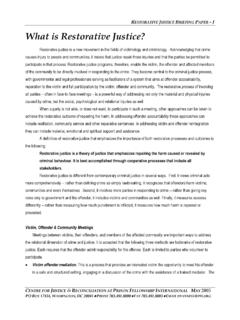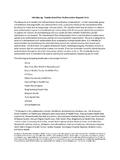Transcription of Tackling Anti-Social Behaviour Learning from experience By ...
1 Tackling Anti-Social Behaviour Learning from experienceByAusten CuttenContentsIntroductionPage 1 defining Anti-Social behaviourPage 2An A-Z of Anti-Social Behaviour measuresPage 4 Anti-Social Behaviour : a balanced approach?Page 8 Learning from experience : case studiesPage 10 Summary of findingsPage 15 Useful contactsPage 16 Tackling Anti-Social Behaviour Learning from experience1 IntroductionAnti- social Behaviour has gained increasing prominence both in the minds ofpolicy makers and local communities. There is a growing perception that thebehaviour of many individuals is spiralling out of control and causingconsiderable harm to others and whole communities.
2 According to the BritishCrime Survey 2003/04 one in five people say that there is a high level ofdisorder in their area and over a quarter of the public perceive particularbehaviours such as vandalism, graffiti, litter and teenagers hanging around asa problem in their local response to this growing concern, the government has established the AntiSocial Behaviour Unit within the Home Office, tasked with driving forward anew policy agenda to tackle Anti-Social Behaviour . In September 2003, theUnit conducted the first ever national day count of Anti-Social Behaviour .
3 Itrecorded 66,107 incidents of Anti-Social Behaviour , equivalent to more thanone report every two seconds or around reports a year. Infinancial terms, Anti-Social Behaviour recorded on the day of the count costagencies in England and Wales at least ; this equates to around a year. The report covered a wide spectrum of activity ranging from litter or rubbishdropping to prostitution, and clearly demonstrated that Anti-Social Behaviour inall its manifestations has a devastating effect both on the daily lives ofindividuals and local communities.
4 Often it is a problem that is more prevalentin deprived neighbourhoods, damaging communities that are already fragileand where services are overstretched. This creates an environment wherecrime can take hold and people begin to feel higher levels of fear or anxietyabout crime in their surprisingly local authorities and other key agencies have a critical role toplay at the local level in developing appropriate strategies and solutions totackle the varied and multifaceted problems many communities face. Much ofthe work in this field is very new and this report examines some of the currentinnovative ways local authorities and other agencies are Tackling theproblems.
5 In particular the report focuses on approaches that seek to changeor challenge patterns of Anti-Social Behaviour , rather than simply manage thebehaviour. Tackling Anti-Social Behaviour Learning from experience2 defining Anti-Social BehaviourDefining Anti-Social Behaviour is often problematic. Usually people sunderstanding of Anti-Social Behaviour is based on their own individualperception of what is and isn t acceptable Behaviour . In addition, it can clearlyinclude Behaviour that is either criminal or non-criminal in nature. The Crime and Disorder Act (1998), which heralded the arrival of anti -socialbehaviour orders, defines it as behaving in.
6 A manner that caused or waslikely to cause harassment, alarm, distress to one or more persons not of thesame household as himself .The accompanying guidance note produced in March 1999 offered furtherclarification. Making it clear that the term did not refer to ..run of the milldisputes , the guidance went on to provide a comprehensive list of situationsto which Anti-Social Behaviour could apply under the Act. These were: violence, threats of violence and other intimidating Behaviour directedat neighbours persistent and unruly Behaviour by a small group of individuals on anestate families whose Behaviour when challenged leads to abuse vandalism graffiti persistent abusive Behaviour towards the elderly or the disabled serious and persistent bullying of children in schools persistent racist or homophobic Behaviour persistent Anti-Social Behaviour as a result of drugs and March 2003, the government s White Paper Respect and Responsibility ,reasserted the government s position.
7 But emphasised the need for a culturalshift from a society where too many people are living with the consequencesof Anti-Social Behaviour , to a society where we respect each other, ourproperty and our shared public spaces . Emphasis was placed on balancingthe rights of individuals with their responsibility to Behaviour in a respectfuland responsible manner towards others. These themes were to be embedded in the subsequent Anti-Social BehaviourAction Plan , produced by the Home Office s anti social Behaviour Unit inOctober 2003, and enshrined in the anti social Behaviour Act which cameinto force in January 2004.
8 The measures contained in the Act build onexisting legislation to give the police, local authorities and other key agenciesa broader range of powers to tackle Anti-Social in order to develop a focus for work aimed at Tackling local anti -socialbehaviour problems agencies need to identify the behaviours that are aparticular problem within their locality, how these behaviours are perceivedand what impact they have locally. Tackling Anti-Social Behaviour Learning from experience3 The Research Development and Statistics Directorate of the Home Office(RDS) has developed a typology of Anti-Social Behaviour , which provides auseful framework and guide to the main categories of Behaviour that arewidely accepted to be Anti-Social Behaviour by both practitioners and copy of the RDS report defining and measuring Anti-Social Behaviour (2004)
9 Can be obtained from the following Anti-Social Behaviour Learning from experience4An A-Z of Anti-Social Behaviour MeasuresThis section outlines some of the key measures introduced by the governmentto tackle Anti-Social Behaviour . It also highlights some of the activeinterventions local practitioners are using to tackle the problem of anti -socialbehaviour in their Behaviour Contracts (ABCs): a voluntary written agreementbetween someone who has been involved in Anti-Social Behaviour and one ormore local agency whose role it is to prevent such Behaviour , such as thepolice or council. By signing the contract, the perpetrator agrees not tocontinue with such Behaviour .
10 If the contract is broken, the person may beserved with an Anti-Social Behaviour Behaviour Orders (ASBOs): Introduced as part of the Crimeand Disorder Act 1998, an Anti-Social Behaviour order is a court order that isused to deter individuals who carry out persistent and serious anti -socialbehaviour. It can be served on anyone over the age of ten and lasts for a minimum of twoyears. An order can contain conditions to prevent the offender fromcommitting specific Anti-Social Behaviour acts, associating with certain namedindividuals or from entering a defined can be applied for by the police (including the British TransportPolice), local authorities, and more recently under the anti social BehaviourAct 2003, county councils, housing action trusts and registered sociallandlords (RSLs).






